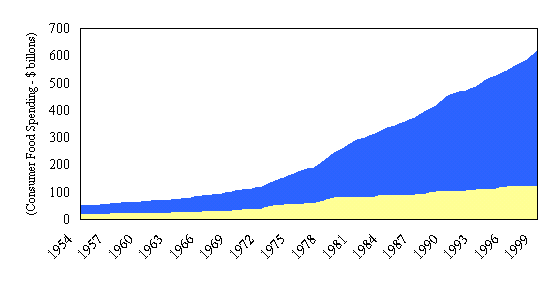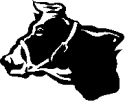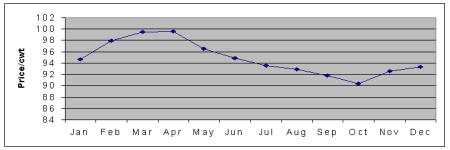

To send a message to an author, click on the author's name at the end of the article.
This Month in Ag Connection | Ag Connection - Other Issues Online
This graph shows dollars spent annually by U.S. consumers for food marketing, transporting, processing, and distributing domestic farm foods. Annual cost covers foods consumed at home and away from home. It excludes foreign-produced foods. It shows total dollars spent for U.S. produced foods and the corresponding farm value of raw U.S. agricultural commodities.

This Month in Ag Connection | Ag Connection - Other Issues Online
The MissouriFamilies eNewsletter has just been released by University Outreach and Extension. This free, weekly email newsletter is for Missouri families and will provide information about health, human development, nutrition, housing, personal finance, consumer issues, parenting and more. You can subscribe to it to stay informed about practical, yet science-based information about topics for Missouri families.
To see a sample issue and/or to subscribe click here.
This Month in Ag Connection | Ag Connection - Other Issues Online

Cattlemen typically think of themselves as livestock producers, but in reality, most produce forages and market them through their cattle. So when should forages be utilized to make the most money? Although market influences may cause cattle prices to rise and fall anytime throughout a given year, over time prices tend to follow a fairly consistent seasonal pattern. The following graph displays the seasonal prices for 400-500 lb feeder steers at Oklahoma City. Prices are bid up and peak during late spring as cattlemen prepare to place calves on grass to take advantage of cheap gains. Prices continue to decline during summer and reach a seasonal low in the fall as new spring-born calves are being weaned.

Although the patterns may be slightly different, prices for each weight category of feeder calves follow their own seasonal trend. The following is the seasonal pattern for 1100-1300 lb finished feeder steers in western Kansas.

Cattleman know that the main factor influencing profitability of a grazing operation is the difference between the price at which calves are bought (or retained) and sold. Research at the University of Missouri has shown that producers' ability to take advantage of the seasonal trends described above can greatly influence profitability.
But how does a producer use the seasonal prices to his or her advantage? The following table shows what the market was willing to pay for an additional 100 lbs of gain to a feeder calf on average from 1990 to 1999. Remember, as calves get heavier the price/cwt goes down on the entire calf weight, therefore the value of the additional 100 lbs will be less than the actual price/cwt. This table represents a combination of each of the individual seasonal pricing patterns. As expected the value of 100 lbs of gain during the summer growing season when grass is plentiful and gains are cheap is worth less than the same gain during winter. However, this value is exaggerated because of the seasonal pricing patterns. Calves purchased or retained in late spring are bought at a high price and as prices decline during summer the value of the gain becomes very low. Alternatively, calves purchased or retained in the fall are purchased at low prices and as prices typically rise during winter it makes the value of that gain much higher.
| Value of 100 Pounds of Gain Feeder Steers 1990-1999 |
|||
|---|---|---|---|
| Starting Weight (lbs.) | |||
| Start Month | 450 | 550 | 650 |
| Dollars/cwt of gain | |||
| January | 74.28 | 59.65 | 48.94 |
| February | 54.95 | 51.49 | 46.33 |
| March | 40.81 | 35.51 | 42.27 |
| April | 37.57 | 41.58 | 52.50 |
| May | 44.63 | 46.06 | 57.65 |
| June | 49.82 | 44.50 | 53.62 |
| July | 41.89 | 42.90 | 50.17 |
| August | 36.23 | 36.66 | 54.73 |
| September | 50.13 | 55.09 | 70.67 |
| October | 64.14 | 68.91 | 86.17 |
| November | 58.08 | 63.18 | 72.55 |
| December | 70.20 | 58.20 | 60.71 |
| Average | 51.89 | 50.31 | 58.00 |
What resources do most Missouri cattlemen have that would allow them to take advantage of this trend? One answer might be stock-piled fescue. A simple strategy would be reducing the stocking rate during the entire growing season, and managing pasture resources to allow for stock-piling fescue. Then in the fall, rather than selling calves at weaning when they are at the yearly low, calves can be retained and placed on the stock-piled fescue. For a stocker operation this is the period when calves can generally be purchased at the lowest price. By simply utilizing the forages during an atypical time of the year, cattlemen can take advantage of the seasonal pricing trends and increase profitability.
Stock-piling requires considerable management to have quality forage. Refer to August 1999 of Ag Connections for information on how to successfully stock-pile fescue. Fertility has a big effect on it, so be sure you soil test and fertilize to correct any deficiencies.
(Author: Wesley Tucker, Farm Management Specialist)
This Month in Ag Connection | Ag Connection - Other Issues Online
Potential environmental pollution from on-farm practices can represent a substantial financial risk to a farmer in today's economic and political environment.
On-farm pollution can result in loss of productivity of the farm's natural resources, reducing income in current and future years as well as decrease property value. Pollution can reach the farm's homestead affecting health of family members and increasing medical care expenses. A pollution event that occurs on the farm can result in pollution of neighboring properties causing neighbors and environmental regulatory agencies to seek damages through civil and criminal court system.
To reduce risk of on-farm pollution, farmers should:
Farm*A*Syst was designed to help determine what pollution risks -- whether from livestock manure, pesticide management, petroleum storage, home sewage treatment -- could threaten a farm family's health and financial security. Farm*A*Syst factsheets provide information on factors influencing pollution risks, health and legal concerns related to specific pollutants and sources of additional information or assistance.
Farm*A*Syst worksheets help individuals evaluate groundwater pollution potential of the farmstead. Topics covered include:
Information gathered in the worksheets is confidential and is not required to be shared with any governmental or local agency. Data gathered by individuals serves as a reference in pollution assessment risk and prioritization of adopting best management practices. Individuals that complete the Farm*A*Syst assessment decide what changes need to be made and when to make them.
Since 1991, thousands of farmers and ranchers throughout the country have used Farm*A*Syst. The program has been recognized nationally and internationally for its common-sense approach to managing environmental risks. Farm*A*Syst has also been used to improve contract scores for government programs such as EQIP (Environmental Quality Incentive Program).
In Missouri, Farm*A*Syst has been adopted by University of Missouri Outreach and Extension and a packet containing these factsheets and worksheets can be obtained from any Extension county office for a cost of $7.50.
Farm*A*Syst is a national program cooperatively supported by the USDA Cooperative State Research, Education and Extension Service (CSREES), USDA Natural Resources Conservation Service (NRCS), and US Environmental Protection Agency (EPA).
(Author: Darin Starr, Regional Ag Engineering Specialist)
This Month in Ag Connection | Ag Connection - Other Issues Online

Farm management specialists have encouraged landlords and tenants to document their rental arrangement in written agreements. Now the IRS is also encouraging written farm lease agreements - if the landlord wants to be considered in the trade or business of farming. IRS Regulations carry a lot of weight, so I expect numerous oral rental arrangements to be put into written form before the next cropping season begins.
In drafting the final Regulations for income averaging, the IRS indicates: "A landlord is engaged in a farming business for purposes of Code Section 1301 (income averaging) with respect to rental income that is based on a share of production from a tenant's farming business and, with respect to amounts received on or after January 1, 2003, is determined under a written agreement entered into before the tenant begins significant activities on the land." It is interesting to note that with regard to the income averaging regulations, whether the landlord materially participates in the farming business is not considered as relevant.
While this IRS Regulation is specific to Code Section 1031 (income averaging), I would expect the IRS to attempt utilizing this logic and definition as to what constitutes a trade or business of farming relative to share-crop landlords in areas of tax law.
(Author: Parman R. Green, Farm Business Specialist)
This Month in Ag Connection | Ag Connection - Other Issues Online
Publishing Information
Ag Connection is published monthly for Northeast and Central areas of Missouri producers and is supported by the University of Missouri Extension, the Missouri Agricultural Experiment Station, and the MU College of Agriculture, Food and Natural Resources. Managing Editor: Mary Sobba.